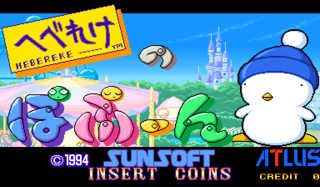Hebereke no Popoon (Arcade)
| Hebereke no Popoon |
|---|
|
Developers: Success[1],
Sunsoft,
KID[2]
|
A port of the classic SNES game made by the creators of the Persona Cotton series. It adds cutscenes and removes a few modes which would later be implemented into Hebereke's Popoitto.
Unfortunately, the cabinet is so rare that's it's not easy to find... the game being sold as a kit and likely never having a dedicated cabinet made for it in the first place not helping matters.
Contents
Unused Music
Victory!!!
(Sound Test ID: 02)
The victory theme from the SNES version.
Lose.....
(Sound Test ID: 03)
The failure theme from the SNES version. These jingles are from the SNES version, but here they play this instead.
Wobbling Pen-Chan
(Sound Test ID: 0E)
Fortunately, the two tracks absent from the SNES version appear in this version of the game. Unfortunately, this one still goes unused here! Poor Pen-Chan just can't catch a break.
Unique Tracks
(Sound Test ID: 11)
(Sound Test ID: 12)
(Sound Test ID: 14)
(Sound Test ID: 15)
These tracks are unique to this version of the game. Possible locations which these tracks could have been intended for include the game's ending and name entry screen, which are oddly lacking music in the final game.
The first unused track shares similarities with the song which directly precedes it in the Sound Test (ID 10), which raises the possibility that they might belong together. The used track appears on Pen-Chan's stage in the final game despite an appropriate existing track already being present, as mentioned.
Unused Graphics
...Roy Koopa from the Super Mario series? Found at the beginning of the cutscene graphics, perhaps his presence was simply a placeholder during development.
References
- ↑ Graphics, Programming and some Sound
- ↑ Nobuyuki Shioda mentions "Converting SE to PCM data" for the game on his website. He worked at KID at the time.
The Hebereke series
| |
|---|---|
| NES | Ufouria: The Saga (Prototypes) |
| SNES | Hebereke's Popoon (Prototype) • Sugoi Hebereke • Hebereke no Oishii Puzzle wa Irimasenka • Hashire Hebereke • Hebereke's Popoitto • O-Chan no Oekaki Logic |
| Arcade | Hebereke no Popoon |
| PlayStation | Hebereke's Popoitto • O-Chan no Oekaki Logic 2 |
- Games developed by Success
- Pages missing developer references
- Games developed by Sunsoft
- Games developed by KID
- Pages missing publisher references
- Games published by Sunsoft
- Games published by Atlus
- Arcade games
- Pages missing date references
- Games released in 1994
- Games released in June
- Games with unused graphics
- Games with unused music
- Games with hidden sound tests
- Hebereke series
Cleanup > Pages missing date references
Cleanup > Pages missing developer references
Cleanup > Pages missing publisher references
Games > Games by content > Games with hidden sound tests
Games > Games by content > Games with unused graphics
Games > Games by content > Games with unused music
Games > Games by developer > Games developed by CyberFront > Games developed by KID
Games > Games by developer > Games developed by Success
Games > Games by developer > Games developed by Sunsoft
Games > Games by platform > Arcade games
Games > Games by publisher
Games > Games by publisher > Games published by Sega > Games published by Atlus
Games > Games by publisher > Games published by Sunsoft
Games > Games by release date > Games released in 1994
Games > Games by release date > Games released in June
Games > Games by series > Hebereke series

